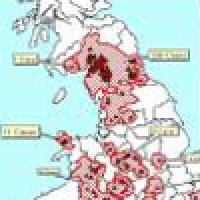
Maths in a minute: The SIR model
Brief summary
The SIR model is the basis most disease modellers use to understand the spread of disease through a population. In its most basic form this model assumes that people in a population are either susceptible to the disease (S), infected with the disease (I) or recovered (R) from the disease.
Mathematical equations describe how people move between being susceptible, infected or recovered. These equations depend on the transmission rate for the disease and also the recovery rate. The model can be used to simulate an epidemic on a computer.
The basic idea behind using maths to try and predict how an infectious disease will spread is surprisingly straight-forward. Suppose you have observed that the number of people infected with a particular disease doubles every three days. Then it's quite easy to work out that, if today we start with a single case and this trend continues, then we will have:
2 cases in 3 days,
4 cases in 6 days,
8 cases in 9 days
and so on. This growth might seem slow at first, but this quickly gets out of control. In just one month we will have over a thousand cases, and just a month later over one million cases. That's the steep growth, known as exponential growth, that can lead to a disease spreading very quickly.
This extrapolation, simple as it may be, highlights the basic ingredients of a model: a mathematical expression which describes how things change over time and the numbers (called parameters) which pin down the exact shape of the change. In our example we have exponential growth over time, and the steepness of this growth is decided by the parameter of the doubling time, which is 3 days.
But if you want longer term predictions you need a more sophisticated model. In our simple example above, in just 99 days we would have more people infected than there are on the whole planet!
The SIR model
The flaw in our first model was that we would eventually run out of people to infect. Instead, imagine a population of people in which everyone is either susceptible to a disease (S), infected (I), or recovered (R) and therefore immune. The way in which people move from being susceptible, to being infected, to being immune, is described by mathematical equations. These equations depend on the transmission rate for the disease and also the recovery rate. This is the famous SIR model. You start the model off with only a small proportion of the population being infected and then let it evolve over time, seeing how the disease spreads and then subsides as people recover and become immune.
Although simple, the SIR model gives good predictions for simple populations, such as students at a boarding school, which form a closed group relatively isolated from the rest of the population. When it comes to more complex populations you can link up many individual SIR models representing different geographical locations and sub-populations, including for example individual towns or schools.
Different disease models are designed for different purposes, such as making short term predictions, long term predictions, or simulating the effect of particular interventions such as school closures. But although models differ, they tend to be built around the SIR model – an approach that has been around since the 1910s.
You can read more about the SIR model, including some of the mathematical details, and what information you need to include to make your model more realistic, in How can maths help fight an epidemic? and The mathematics of diseases.
This article is part of our collaboration with JUNIPER, the Joint UNIversities Pandemic and Epidemiological Research network. JUNIPER is a collaborative network of researchers from across the UK who work at the interface between mathematical modelling, infectious disease control and public health policy. You can see more content produced with JUNIPER here.
